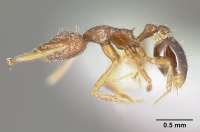Strumigenys consanii
| Strumigenys consanii | |
|---|---|

| |
| Scientific classification | |
| Kingdom: | Animalia |
| Phylum: | Arthropoda |
| Class: | Insecta |
| Order: | Hymenoptera |
| Family: | Formicidae |
| Subfamily: | Myrmicinae |
| Tribe: | Attini |
| Genus: | Strumigenys |
| Species: | S. consanii |
| Binomial name | |
| Strumigenys consanii Brown, 1954 | |
Longino (Ants of Costa Rica) speculated this ant could be arboreal as it had been collected from under epiphytes. A subsequent collection was obtained from a litter sample in mature forest, which suggests arboreal nesting of Strumigenys consanii is adventitious.
Identification
Bolton (2000) - A member of the Strumigenys elongata-group. Within the group the combination of characters noted in the description will immediately isolate consanii. In all other species the following contrasting characters are present.
1 Cephalic dorsum with only a single pair of short erect hairs, near the occipital margin.
2 Ventral surface of petiole without a spongiform lobe beneath the node.
3 Disc of postpetiole mostly or entirely reticulate-punctate.
4 Basigastral costulae fine but conspicuous.
5 Standing hairs on first gastral tergite either flagellate, remiform, or otherwise modified; not as described above.
Longino (Ants of Costa Rica) - Apical fork of mandible with no intercalary teeth; mandible with no preapical teeth; postpetiole swollen, its dorsum smooth and shining; setae on gaster straight, not bent or coachwhip-like.
Keys including this Species
Distribution
Latitudinal Distribution Pattern
Latitudinal Range: 10.3085492° to -2.633333333°.
| North Temperate |
North Subtropical |
Tropical | South Subtropical |
South Temperate |
- Source: AntMaps
Distribution based on Regional Taxon Lists
Neotropical Region: Costa Rica (type locality).
Distribution based on AntMaps
Distribution based on AntWeb specimens
Check data from AntWeb
Countries Occupied
| Number of countries occupied by this species based on AntWiki Regional Taxon Lists. In general, fewer countries occupied indicates a narrower range, while more countries indicates a more widespread species. |

|
Estimated Abundance
| Relative abundance based on number of AntMaps records per species (this species within the purple bar). Fewer records (to the left) indicates a less abundant/encountered species while more records (to the right) indicates more abundant/encountered species. |

|
Biology
Castes
Images from AntWeb

| |
| Worker. Specimen code inbiocri001284017. Photographer D. J. Cox, uploaded by California Academy of Sciences. | Owned by JTLC. |
Nomenclature
The following information is derived from Barry Bolton's Online Catalogue of the Ants of the World.
- consanii. Strumigenys consanii Brown, 1954c: 192 (w.) COSTA RICA. See also: Bolton, 2000: 509.
Unless otherwise noted the text for the remainder of this section is reported from the publication that includes the original description.
Description
Worker
Bolton (2000) - TL 3.0-3.2, HL 0.66-0.71, HW 0.52-0.55, CI 77-79, ML 0.41-0.42, MI 59-63, SL 0.45-0.50, SI 85-91, PW 0.32-0.34, AL 0.76-0.78 (3 measured).
Cephalic dorsum with two pairs of erect slender hairs, one near highest point of vertex, the other near occipital margin. Mesopleuron and metapleuron mostly smooth. Declivity of propodeum with a narrow lamella subtending the spine, its posterior (free) margin concave. Ventral surface of petiole with a cuticular carina below the peduncle that may appear punctulate but is not spongiform; posteriorly, below the node, there is a small spongiform lobe. Disc of postpetiole glassy smooth. Basigastral costulae vestigial. Standing hairs on first gastral tergite fine and simple, short stiff and erect, pointed or truncated apically.
Type Material
Bolton (2000) - Holotype and paratype workers, COSTA RICA: La Palma, 1500 m. (Tristan) (Museum of Comparative Zoology, National Museum of Natural History) [examined].
References
- Bolton, B. 2000. The ant tribe Dacetini. Memoirs of the American Entomological Institute. 65:1-1028. (page 509)
- Brown, W. L., Jr. 1954c [1953]. The neotropical species of the ant genus Strumigenys Fr. Smith: group of elongata Roger. Journal of the New York Entomological Society. 61:189-200. (page 192, worker described)
- Brown, W. L., Jr. 1962c. The neotropical species of the ant genus Strumigenys Fr. Smith: synopsis and keys to the species. Psyche. 69:238-267.
References based on Global Ant Biodiversity Informatics
- Bolton, B. 2000. The Ant Tribe Dacetini. Memoirs of the American Entomological Institute 65
- Brown W. L. Jr. 1962. The neotropical species of the ant genus Strumigenys Fr. Smith: synopsis and keys to the species. Psyche (Cambridge) 69: 238-267.
- Kempf, W.W. 1972. Catalago abreviado das formigas da regiao Neotropical (Hym. Formicidae) Studia Entomologica 15(1-4).
- Longino J. T. L., and M. G. Branstetter. 2018. The truncated bell: an enigmatic but pervasive elevational diversity pattern in Middle American ants. Ecography 41: 1-12.
- Longino J. T., and R. K. Colwell. 2011. Density compensation, species composition, and richness of ants on a neotropical elevational gradient. Ecosphere 2(3): 16pp.

